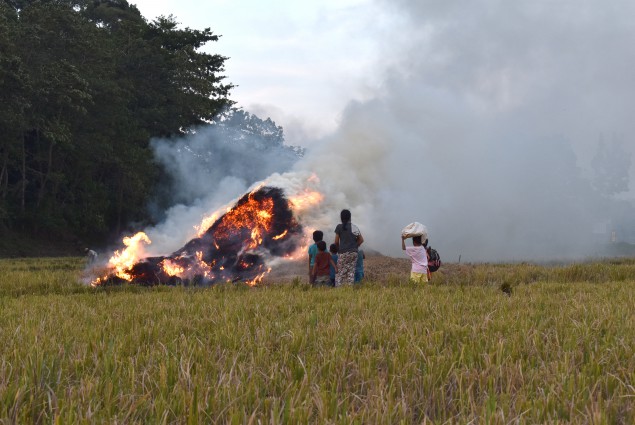Harvest is fast approaching. At last, Mang Juan will be reaping the reward of more than three months of caring for his rice plants. He’s not only excited for harvest, but also for the rice straw, locally known as dayami, that he will get. This will give him more income as fertilizer and as growing medium for his mushrooms.
Evelyn F. Javier, supervising science research specialist of Agronomy, Soil, and Plant Physiology Division said that not burning rice straw can lessen fertilizer cost in the long run.
On average, the country produce 15.2 million tons of rice that leave 11.3 million tons of rice straw annually. Unlike Mang Juan, most farmers usually burn rice straw after harvest to speed up land preparation.
Aside from possible lost income, burning of rice straw also emits harmful air pollutants, such as carbon dioxide, carbon monoxide, nitrogen oxide, and sulphur dioxide. If continually done, it will deplete the soil’s nitrogen, 25% of phosphorus, 20% of potassium, and 5-60% of sulfur.
Trash to cash
The Solid Waste Management Act (RA 9003) and Philippine Clean Air Act of 1999 prohibit open-field burning, including burning of rice straws.
Instead of burning, farmers can opt to do the following:
1. Incorporate back to the soil
This practice helps maintain soil nutrient by maintaining soil moisture and improving nutrient holding capacity. Javier recommended incorporation during dry land preparation to help reduce methane emission. Farmers may also choose off-site decomposition or vermicomposting. Javier added that this also preserves the biodiversity of microorganisms that help in nutrient cycling and efficient fertilizer utilization.
2. Mulch
Rice straws can also be used as mulch for other crops such as vegetable, to preserve moisture and protect the roots of the plants from the heat and cold. They also help slowdown weed growth.
3. Mushroom substrate
Rizal G. Corales of PhilRice’s Palayamanan Plus recommended the use of rice straws as substrate for oyster (Pleurotus spp.), Volvariella, Ganoderma, and Calocybe mushroom production.
4. Use as substrate for vermicomposting
Corales also said that the waste from mushroom production is also the main substrate for vermicomposting, one of the best organic fertilizers produced.
5. Fodder for cattle
Philippine Carabao Center published that using rice straw as fodder is good for cattle production.
“Although rice straws have low protein content (4-4.5 %), it can be sprayed or treated with molasses and urea to increase its nutritive value and feeding quality. The urea-treated rice straws’ protein content ranges from seven to nine percent. When fed to dairy buffaloes, the feed intake is increased by 12%, milk production is improved by 18% and it increases the farmer’s profitability by 33% ,” the Center study showed.





